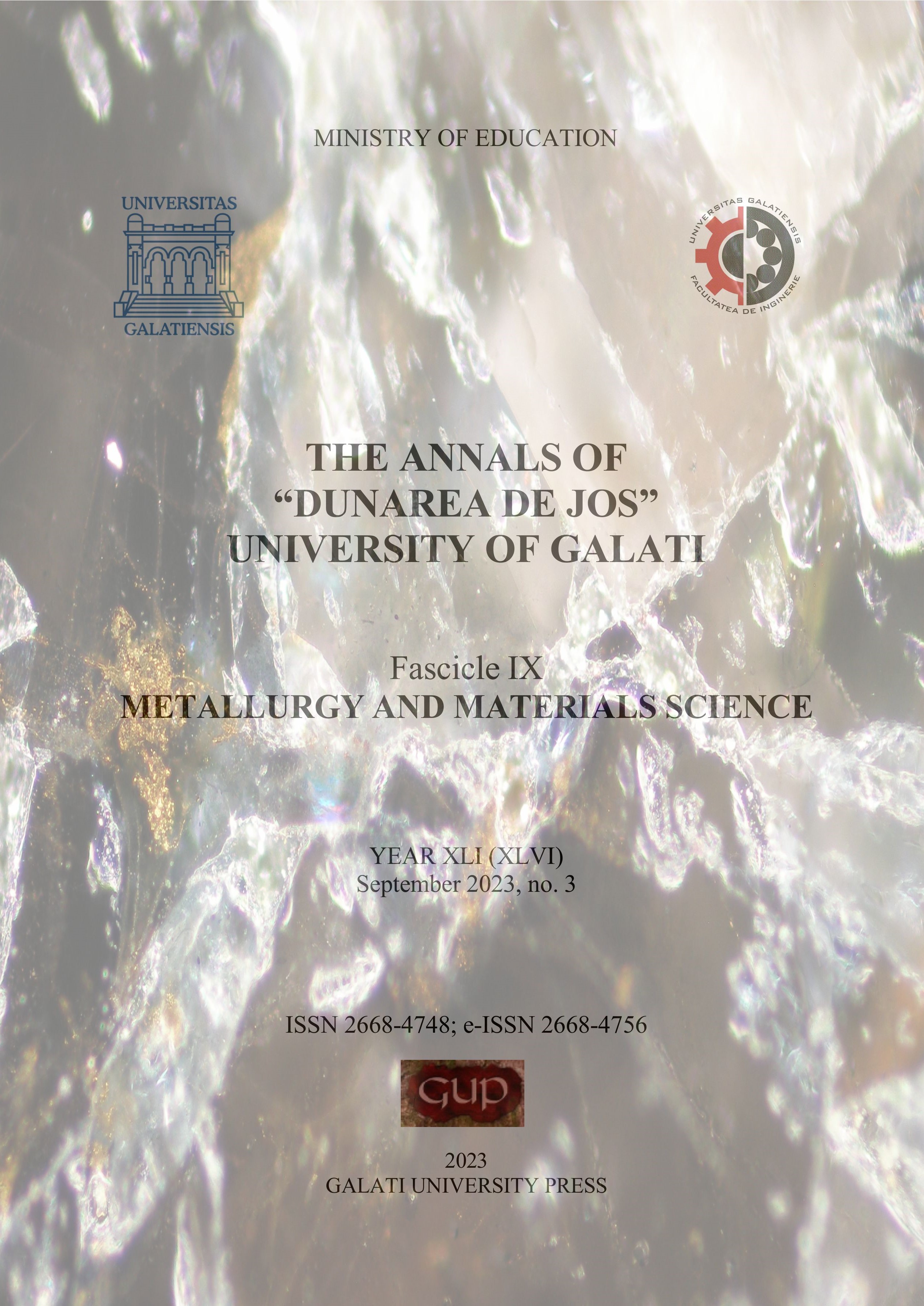Determination of Stress Concentration Factor for a Rectangular Bar with Fillet Under Axial Loading: An Artificial Neural Networks Approach
Keywords:
Stress Concentration Factor (SCF), Artificial Neural Network (ANN), axial loading
Abstract
Using computer techniques, stress concentration factors from the graphs can be converted into numerical values. Stress concentration factor values were collected in a database and an Artificial Neural Network (ANN) model can be developed for improving and extending the database. ANN model provides accuracy in obtaining the stress concentration factor values.
Downloads
Download data is not yet available.
References
[1]. Boger Z., Guterman H., Knowledge extraction from artificial neural network models, IEEE Systems, Man, and Cybernetics Conference, Orlando, FL, USA, 1997.
[2]. Budynas-Nisbett, Shigley’s Mechanical Engineering Design, 8th Edition.
[3]. Haykin S., Neural Network: A Comprehensive Foundation, New York, Macmillan, 1994.
[4]. Abhishek K., Kishore D. J., Prakashkumar Kavalur, Akshay N. H., ANN modeling for prediction of cutting force component during orthogonal turning, International Research Journal of Engineering and Technology (IRJET), vol. 5, issue 6, June 2018.
[5]. Souâd Makhfi, Raphaël Velasco, Malek Habak, Kamel Haddouche, Pascal Vantomme, An Optimized ANN Approach for Cutting Forces Prediction in AISI 52100 Bearing Steel Hard Turning, p-ISSN: 2163-2669, e-ISSN: 2163-2677, 3 (1), p. 24-32, doi: 10.5923/j.scit.20130301.03, 2013.
[6]. Maunayri H., Novel Artificial Neural Networks Force Model for end Milling, Springer, International Journal of Advanced Manufacturing Technology, 18, p. 693-700, 2001.
[7]. Krzysztof L. Molski, Stress concentration at load-carrying fillet welded cruciform joints subjected to tensile and bending loads, Acta mechanica et automatica, vol. 13 no. 4, DOI: 10.2478/ama-2019-0033, 2019.
[8]. Pilkey Walter D., Pilkey Deborah F., Peterson’s stress Concentration Factors, 3rd Edition.
[9]. Saurabh Karsoliya, Approximating Number of Hidden Layer neurons in Multiple Hidden Layer BPNN Architecture, International Journal of Engineering Trends and Technology, vol. 3, issue 6, 2012.
[10]. Ihsan Toktas, Murat Tolga Ozkan, Fulya Erdemir, Nurullah Yuksel, Determination of Stress Concentration Factor (Kt) for a Crankshaft under Bending Loading: An Artificial Neural Networks Approach, Politeknik Dergisi, Journal of Polytechnic, ISSN: 1302-0900 (PRINT), ISSN: 2147-9429 (ONLINE), 2020.
[11]. Alan J. Thomas, Miltos Petridis, Simon D. Walters, Saeed Malekshahi Gheytassi, Robert E. Morgan, On Predicting the Optimal Number of Hidden Nodes, International Conference on Computational Science and Computational Intelligence, 2015.
[12]. Warren C. Young, Richard G. Budynas, Roark’s Formulas for Stress and Strain, 8th Edition.
[13]. ***, https://mechanicalc.com/calculators/stressconcentration/.
[14]. ***, MATLAB 2018a, The MathWorks, Inc., Natick, Massachusetts, United States.
[2]. Budynas-Nisbett, Shigley’s Mechanical Engineering Design, 8th Edition.
[3]. Haykin S., Neural Network: A Comprehensive Foundation, New York, Macmillan, 1994.
[4]. Abhishek K., Kishore D. J., Prakashkumar Kavalur, Akshay N. H., ANN modeling for prediction of cutting force component during orthogonal turning, International Research Journal of Engineering and Technology (IRJET), vol. 5, issue 6, June 2018.
[5]. Souâd Makhfi, Raphaël Velasco, Malek Habak, Kamel Haddouche, Pascal Vantomme, An Optimized ANN Approach for Cutting Forces Prediction in AISI 52100 Bearing Steel Hard Turning, p-ISSN: 2163-2669, e-ISSN: 2163-2677, 3 (1), p. 24-32, doi: 10.5923/j.scit.20130301.03, 2013.
[6]. Maunayri H., Novel Artificial Neural Networks Force Model for end Milling, Springer, International Journal of Advanced Manufacturing Technology, 18, p. 693-700, 2001.
[7]. Krzysztof L. Molski, Stress concentration at load-carrying fillet welded cruciform joints subjected to tensile and bending loads, Acta mechanica et automatica, vol. 13 no. 4, DOI: 10.2478/ama-2019-0033, 2019.
[8]. Pilkey Walter D., Pilkey Deborah F., Peterson’s stress Concentration Factors, 3rd Edition.
[9]. Saurabh Karsoliya, Approximating Number of Hidden Layer neurons in Multiple Hidden Layer BPNN Architecture, International Journal of Engineering Trends and Technology, vol. 3, issue 6, 2012.
[10]. Ihsan Toktas, Murat Tolga Ozkan, Fulya Erdemir, Nurullah Yuksel, Determination of Stress Concentration Factor (Kt) for a Crankshaft under Bending Loading: An Artificial Neural Networks Approach, Politeknik Dergisi, Journal of Polytechnic, ISSN: 1302-0900 (PRINT), ISSN: 2147-9429 (ONLINE), 2020.
[11]. Alan J. Thomas, Miltos Petridis, Simon D. Walters, Saeed Malekshahi Gheytassi, Robert E. Morgan, On Predicting the Optimal Number of Hidden Nodes, International Conference on Computational Science and Computational Intelligence, 2015.
[12]. Warren C. Young, Richard G. Budynas, Roark’s Formulas for Stress and Strain, 8th Edition.
[13]. ***, https://mechanicalc.com/calculators/stressconcentration/.
[14]. ***, MATLAB 2018a, The MathWorks, Inc., Natick, Massachusetts, United States.
Published
2023-09-15
How to Cite
1.
BOAZU D. Determination of Stress Concentration Factor for a Rectangular Bar with Fillet Under Axial Loading: An Artificial Neural Networks Approach. The Annals of “Dunarea de Jos” University of Galati. Fascicle IX, Metallurgy and Materials Science [Internet]. 15Sep.2023 [cited 16Jan.2026];46(3):20-8. Available from: https://www.gup.ugal.ro/ugaljournals/index.php/mms/article/view/6247
Issue
Section
Articles



